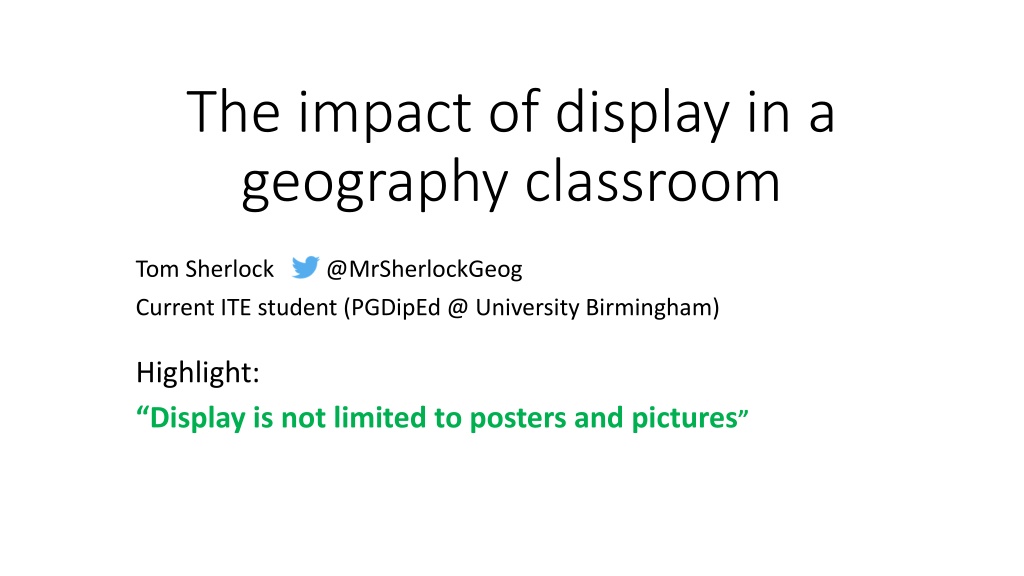The impact of display in a geography classroom
Effective display techniques in a geography classroom can support students in improving geographical literacy, aid teachers in enhancing their teaching methods, and create an engaging learning environment. This approach goes beyond traditional posters and pictures to include strategic use of maps, globes, and visual aids that challenge misconceptions, stimulate curiosity, and simplify complex concepts. Research questions explore the impact of classroom displays on student focus and assessment accuracy, highlighting the importance of thoughtful display implementation for optimal learning outcomes.
Download Presentation

Please find below an Image/Link to download the presentation.
The content on the website is provided AS IS for your information and personal use only. It may not be sold, licensed, or shared on other websites without obtaining consent from the author. Download presentation by click this link. If you encounter any issues during the download, it is possible that the publisher has removed the file from their server.
E N D
Presentation Transcript
The impact of display in a geography classroom Tom Sherlock @MrSherlockGeog Current ITE student (PGDipEd @ University Birmingham) Highlight: Display is not limited to posters and pictures
Research questions Are classroom displays disruptive? How can we use display in geography classrooms to improve learning?
Disruptive classrooms review of research Arguments into whether students retain focusin a busy classroom environment Would assessment accuracy improve in plain classrooms? A counter argument of whether assessments should be completed outside of the normal classroom? Important note: Much of the research has been conducted within Primary education. As students get older they learn to regulate focused attention better.
Three main strands for effective display Supporting students Supporting teaching Promoting an engaging learning environment
1. Support (for students) Display can be used to: Enhance and encourage geographical literacy Simplify and clarify exam question terminology
Display doesnt have to be on the wall Personal writing pads for desks - Focus on geographical literacy - Scaffolded sentence starters and command words - Generic SPaG support
2. Support (for teachers) Display is a fundamental support mechanism for teaching geography Geography is a subject that flourishes with visual representation. I always look for any opportunity to use objects in the classroom to model a concept or process. My pick: Globes can be used to explain abstract thinking such as visualising different map projections
Maps I think maps are an essential in every geography classroom as they: Change the way our students view the world Challenge misconceptions about size/shape/proportion Can visualise statistics for many topics (eg development/population) Can stimulate geographical questioning and inquisition from students
Question Matrix - Students can visualise how questions can link together - Students can use the matrix to create their own geographical questions (eg: starter for a new topic) - Can be modelled into a case study grid for students to answer each box with information
Including the relevant geography Geography in the news displays: To link curriculum content to real world geography Teachers can use current issues in activities/debating sessions For ultimate efficiency have a weekly/monthly student rota where students work in teams to pick their favourite geography news articles and an opinion panel.
3. Classroom Environment One of the most effective uses of display is to promote a classroom environment that is conducive to learning: Engagement Extensions (stretch and challenge) Starters/plenaries
Promote geographical thinking live display live display How does this link to Geography?
Research questions Are classroom displays disruptive? Little evidence to suggest significant impact on focus levels in Secondary School. Although displays are not effective if they are static and serve no specific purpose other than for visuals. How can we use display in geography classrooms to improve learning? Can support and enhance instructional delivery (teacher-led) Can promote student engagement and enhance geographical literacy Could help create an environment conducive to learning
Overall assessment Overall assessment Display has the potential to significantly enhance learning in geography. Effective uses of display will be dynamic and serve a specific purpose. Having a good visualappeal of display is far lesseffective than regular communication with students of wheretofind and howtoaccess the information within them.

























